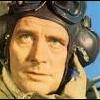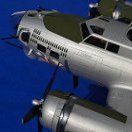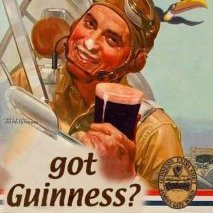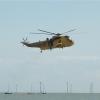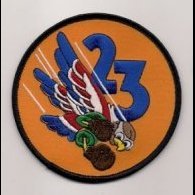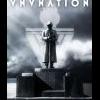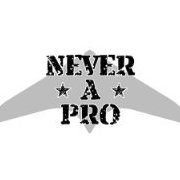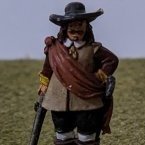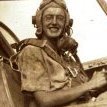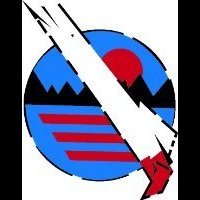Search the Community
Showing results for tags '1/48'.
-
Hi all After I finished my Italeri Westland Wessex HAS31B model I mulled over what kit to get out of the stash next - after a lot of deliberation I settled on the 1/48 scale Sword Fairey Gannet AEW3. I decided from the start I would have to model it with wings folded which meant I needed to scratch build the folded wing mechanism. I decided to tackle this first in case I was not able to recreate the folded area successfully - once I got that moving along, I would start on the fuselage interior but until then taped the fuselage halves together to concentrate on the wings. I have now got the basic details and alignment of the folded wings looking like it's all going to work out - I started working on this kit in early January this year so now have a bit of catching up to do writing this WIP. References as well as the following Warpaint book below were various walkaround sites with the one here on Britmodeller being very useful - others I referenced included http://nabe3saviation.web.fc2.com/waGanno1.html http://www.primeportal.net/hangar/luc_colin/aew3_walk_1.htm Not to forget Massimo's Ark Royal air wing including an AEW3 in 1/72 I started by separating the three wing sections & then made up some sketches to work out the locations of the various components - then I started shaping & cutting out the wing ribs the edges of the wing breaks were thinned down with an 8 inch second cut flat file followed by some emery paper/sanding sticks While I worked on the wings I also detailed the main wheel bays - the hydraulic lines were from household wire with the insulation stripped off - the loose ends were soldered together to help to stop them coming apart when installing them. The wheel bays were detailed by referring to the walkaround photos - the complex tangle of pipes & fittings were done with solder wire I initially tried to make the wingfold hinges from thin plastic strip but they broke very easily - I then found out that you can buy square brass wire & ordered from Amazon an assorted pack of 0.63mm,0.8mm,1.0mm,1.3mm thicknesses & used the 0.63 wire to solder up a bracket with some thicker brass channel for the top link. I made the outer wing panel brackets from a scrap etched sheet that had right angle sections - the mid wing panel is also supported by square wire drilled into the fuselage locating point & wing panel - this also will give the folded wings strength - when the wings are finally assembled, they will also have the long jury struts made from brass tube from the mid wing to the underneath of outer panel. The beginnings of the hydraulic ram & pushrod were made from Albion Alloys slide fit aluminium tube - the bend was made by filing a notch in the thin tube with a small triangular file before gently folding the rod - still working out how to complete it - there is a rather complex looking bracket mid-way along that I guesstimated the shape referring to photos - in fact the whole wing fold area has all been guesstimated as scale drawings seem hard to come by so it is an artistic impression at best. So that is where the folded wings are up to at this stage - the wing panels are dry fitted to see how it all is looking There have been a nice couple of Sword 1/48 AEW3 Gannets posted in RFI & mention was made that the main undercarriage legs were about 2mm short so I cut off the bottom of the leg, added a spacer & decided to scratch build a new part to attach the main wheels on as the axle stub looked very short & would possibly be a weak join. Ok then I think that has brought me up to date & will continue on slowly - I will fit out the interior & glue the fuselage together next, I think. thanks for looking Chris
- 13 replies
-
- 14
-

-

-
Greetings from Australia. After much procrastinating about what kit to build for this GB, I’ve chosen Airfix’s 1980 moulded 1:48 Mosquito Mk. VI. At the time of its release, this kit was ‘THE’ Mosquito kit to have. It eclipsed everything before it and pretty much held its own until Tamiya graced us with their excellent selection of 1:72 and 1:48 kits in the late 1990’s. I first heard about this kit when it featured quite prominently at the start of the 1977 Airfix Catalogue and since then have always wanted to build one. I have no idea why it took a number of years to eventually be released as the year ‘1980’ is clearly embossed inside one of the fuselage halves? For its day this was quite a well detailed kit and from what I’ve read in old magazines it was initially designed as a 1:24 scale Superkit. Cockpit detail probably matches what Monogram were doing at the time, however the undercarriage is a little plain in comparison. On the plus side, it looks to hit all the right accuracy points and once built up has that Mosquito stance that ticks even more boxes. A while back, I hunted down an initial issue ‘New’ kit in the hope of ensuring the kit parts were as crisp as possible, however I have to say, my examples moulds seems to have suffered badly in certain places. There are quite a few sink hole marks and the engine pylons are warped to some strange degree. Thankfully I also possess an example of the ‘re-tooled’ Mk XVI kit and here Airfix kindly supply a whole Mk. VI kit along with upper wings, nacelles and fuselage halves to make the dedicated box version. Inside the box you almost get two complete kits, so I’ll use the better moulded parts here to help me with this GB build. Chosen Scheme? My choice of scheme is No.47 Squadrons’ KU:H RF942. This is an early Post War machine that along with 84 and 110 Squadrons performed air strikes against the Indonesian Independence movement after the collapse of the Japanese occupation forces at the end of WW2. I’ll try to print my own Squadron codes, so we’ll see how well that goes! As with ‘most / all’ SEAC based Mosquitoes, tropical filters are also required and thanks to a talented local Aussie modeller, I now have a set of resin tropical intakes for this build (thanks Uncle Les!). Enough of the long waffle, best of luck to all STGB modellers and roll on the 29th of March. Cheers.. Dave
- 7 replies
-
- 9
-

-
- Airfix Classic
- 1/48
-
(and 1 more)
Tagged with:
-
Afternoon all, My first completion of 2025 is Sanger's 1/48th scale Handley Page Halifax BIII, NA222, O-Oscar of 640 Squadron, RAF Leaconfield, Spring 1945. If you want a 1/48th scale Halifax, options are rather limited at the moment with the nightmare that is Fonderie's limited-run injection kit or the venerable Sanger (ex-Contrail) vacuform. Having wrestled the Fonderie kit into submission a couple of years a go, I fancied another 1/48th Halibag so dived into the Sanger kit. As vacs go, it's not bad at all - nicely moulded parts and lots of white metal bits to keep you happy. I did, however, substitute some spare Fonderie engine cowls and propellers and grafted them on, as well as the wheels. The Sanger kit gives an interior of sorts but I scratch-built my own, as well as the gear bays, bomb bays and various other parts. For a full run-down of what went into this build, the WIP is here. It was painted with Xtracolor's enamel range, with decals from Fantasy Print Shop (code letters) as well as the spares box. Some Mig pastels completed the weathering in high-traffic foot-traffic areas as seen on reference pics. Handley Page Halifax BIII, NA222, O-Oscar, 640 Squadron, RAF. And here's one I made earlier - alongside the Fonderie kit: As always, comment and critique gratefully received! Tom
- 39 replies
-
- 77
-

-

-

-

-

-
Now that the Tamiya jeep is nearly done - just have to spray a matte coat and add the windshields - I'm turning my attention to the Revell 1/48 P-51D. This is a release of the old Monogram kit that was originally released in 1977 and that I built in the early 80s. I'm pretty sure there was limited paint involved - just build it and decal it! I picked this kit up at a local hardware store that actually has a small stock of Revell kits and Testors paints. I'm planning on doing the Robert Welch scheme which I find more interesting than BBD - plus the checker cowling decals are a bit beyond my skillset right now. All interior parts were primed with Mr. Surfacer 1000 and then given a coat of green chromate (4:1 ratio of Tamiya XF4:XF5). I was going to airbrush the instrument panel today but it's too cold in my garage where I do my airbrushing - even with a space heater on the bench the paint wasn't flowing well through my Paasche H.
-
I’m excited to announce the start of this Zoukei-Mura F-4D 1/48 Phantom as part of a buddy build with some modelers on Instagram. I chose the ZKM Phantom after reading tons of great reviews. Along with the kit, I also have the following accessories: Quinta Studio 3D Interior decals Reskit AIM-9B Sidewinders Reskit AIM-7E Sparrows Reskit Exhaust Nozzle Reskit FOD set Mini Craft Collection M.B. Mk-H7 ejection seats I plan on doing the SEA camo pictured on the box art. Jumping straight into the build this weekend by painting up these fantastically detailed ejection seats from Mini Craft Collections: It was quite challenging painting the ejection handles in their yellow/black striping. I redid them about 4 times each and ended up just having to be satisfied enough with them not being super crisp. Once in the cockpit, it would be near impossible to really see how detailed those handles are without zooming in a great deal.
- 32 replies
-
- 15
-

-

-
Well might as well jump right in to the fray. I managed to snag one of Gerald Elliott's B-52s. It is a beast and a half. Its not a bad set up but you definitely need some serious acreage to hang from the ceiling or even build on the bench. Here are a few images of the pieces. I have a few more research items to locate, mainly interior of the wing spoilers.
- 118 replies
-
- Sanger Special Hobby
- 1/48
-
(and 1 more)
Tagged with:
-
A long time at home, lots of cardboard, spare time. Let’s face it that’s a bad combination for silly ideas. Some years ago I started a project to build a Hardened Aircraft Shelter (HAS) form cardboard. I reasoned at the time that it would make a good diorama to show off my 1/48 Cold War Jet builds. And it has done that very well. Now I originally settled on the HAS as a compromise on size. I had originally looked at making a hangar. But that is silly. An RAF Type C hangar would fit the bill. Like the ones at Wattisham. Now in 1/48 that would be about a metre wide and nearly 2 metres long. See? The idea is plain silly. But maybe just the front of the hangar, to act as a backdrop. Or maybe the front part with a mirror in it. Like @Mancunian airman’s T2 hangar. Pose things something like this Or this Type C Hangars to me just look right So now the time element comes in. I started scribbling some measurements We had a delivery of Ikea furniture a little while ago and the boxes hadn’t gone to the tip. In the boxes are some nice reinforced packing strips too. So taking the measurements, a ruler, a pencil and a Stanley knife I thought I would see what it would look like. The is an end - nearly 1m wide, ready for the doors to be cut out. The strip on top is one of the reinforcing strips that could work So a bit more cutting out & a Harrier for scale just for scale too that is a full size fridge & freezer behind. Yep this is madness. So that is one end, one set of doors. How big would a whole hangar be again? So what if I double all of the walls with packing corrugated card. Make 2 ends, two sides, a floor & a roof that lifts off. All parts go flat. Really not keen to build the 11 roof sections with associated steel work. More making a slot together scale hangar. Finally a backdrop that will even make my Hercules look, well not quite small, but you get the idea....
-
Being a serial starter (only occasional finisher) I decided to start something that shouldn't be too complex, the well known Tamiya He-162. I will try to build it as the interesting looking Black 27, interesting looking since it was left partly unpainted and rough which I think sums up the last desperate weeks of the Third Reich, and with a brown left wing and green right wing since they just fitted whatever was available at the time. As it looks otherwise complete it wouldn't surprise me if it had been flown into combat in that state if the war had gone on for a few more weeks. Could also be a fun challenge to replicate the bare metal and spackling look, and the included kit decals should provide the black "27" of Heinkel He 162 A-1 Werknummer 300027 found at Junkers-Jager Bernburg if I cut out the numbers from the kit supplied serial numbers. As you can see, Black 27 didn't have a serial number on the tail plane, nor a swastika. As far as I know the only difference between an A1 and the A2 the kit depicts, is the use of the short barrelled 30mm MK-108 guns in the A1 instead of the MG-151 in the A2. So I'd only need to leave out the protruding barrels from the kit and add the bigger 30mm ejector shell openings and paint the gun ports black, but if any He-162 experts on here knows more please let me know. If my plan goes pear shaped I will just build it as the "Nervenklau" plane from the kit, as I have several noisy motorcycles myself and I think the story behind that plane's name is quite amusing. It will be built out of the box (with the exception of a Quickboost REVI 16b gun sight), but with some attempts to improve detail. The kit detail is fine out of the box but it can be improved without too much work. The build starts in the cockpit (cue surprised gasps), and here Tamiya has left out the grab rails on the ejector seat so they were added using stretched sprue, and four roller wheels were punched out and glue to the seat. Added a few crinkles in the leather as well to add some life into it. I think, or rather hope, the seat supplied in the kit is OK for an A1 as there are at least two different variants of the 162 seat. Some riveting was added to the bulkhead, and the holes were opened up since there is some cabling and other stuff supposed to pass through them. The right hand cockpit side wall got a few punched out disks added to beef up the oxygen regulator. The kit's oxygen apparatus doesn't look much like the real thing, but I've seen so many different variations of the He-162 cockpit that I really don't know how it originally looked, or what has been changed or added by the allies after they took them as war prizes. Drilled out the hole for the flare gun port, and added some rivets to that as well. Still lots to do, so better just crack on!
- 25 replies
-
- 13
-

-

-
Just completed my Monogram ProModeler F-4E. It is the Hasegawa E with the J kit "hard wings", i.e. no leading edge slats. Overall not a bad kit for its age, but the Hasegawa molds were getting old by the time these kits were produced. Here is the build thread: The inspiration for the build was this photo, posted on the F-4 google group that I frequent. It is also on the Phantom (or maybe the 388th TFW) Wikipedia page, so not copywrited I guess. Here is my interpretation in 1/48th. Paints are a mix of different brands because I didn't have all of the colors in one brand. FS 34079 dark green and 34102 medium green are Hataka lacquers. FS 30219 tan is a mix of Testors Model Master enamel FS 30219 and ~40% flat white to lighten it up. The underside FS 36622 light gray is Vallejo White Gray acrylic. The Hataka lacquers are easy to work with and cover very well, but I didn't have the tan or light gray that I liked. Metal areas on the tail are Vallejo metal color acrylics. Decals are likewise a mix of kit decals, which worked ok, Caracal star and bar insignia, and on the tail Aeromaster "JV", Detail & Scale "AF 70" and another white number set for the "301". If the weather was better here in the Pacific Northwest today I would have taken some photos outside, but we have low overcast and steady rain. Maybe next week I can take it outside. External stores are the kit AIM-7 in the left forward missile well, Royal Jet 600 gal centerline tank, Hasegawa weapons set AGM-112 Bullpups on the wing inboard pylons and outboard MERs with Eduard SUU-30 cluster bomb units. The CBUs aren't actually correct per the source photo, but as close as I could find last year. I just saw a couple of weeks ago the 48ers had a set that were correct, with the flat plates on the tips of the tail fins. Forgot who makes them... A couple of notes on the above photo: The camo on some of the USAF jets wrapped around the leading edge of the wings a bit. I opted for that here. Also, since the Hasegawa intakes just end, rather than paint them black I went with white and made some engine compressor face drawings on the computer and glued them inside against the back wall. Almost looks like engines back there. I did this on a Hasegawa F-16 several years ago and it looked ok. In the real world the engines put out a lot of black smoke and the soot blanketed the tail. I just sprayed some diluted flat black behind and under the nozzles and stabs. No need to fancy it up with heat-stressed metallic golds and blues. Questions and comments welcome. Thanks for following along.
- 12 replies
-
- 48
-

-

-

-
There is something about a bit Monogram kit. Not many parts, solid kits, just nice to build. I have a B-17G and the DC3. And there is something about the venerable old Dak. So what is it about the old DC-3? Well my grandad was at Arnhem. And the wartime schemes always looks good. But going to Duxford as a kid there were these colourful civil schemes there. The Air Atlantique fleet. So when it came to choosing a scheme I quickly decided. So G-AMPO. The kit is an earlier DC-3 so I need to modify the rear door to double cargo doors, and shorten the rear end as I think she was a glider tower at some point and had the squared off end. Lights & motors? Seems an idea. Decals - well the exist in 1/72 and thanks to a special print by Ray I now have them in 1/48 I do love it when you get a handful of parts out with some masking tape and you get a sense of the size of the kit. With a Cessna 150 for scale (also a Duxford based aircraft!) No doubt progress won’t be fast & I probably won’t have the right motors or leds or sockets or something but I have been quite looking forward to this. Will be good if I can get the B-17 done as Sally B to go with her. Proper Duxford reunion.
-
Hello! I see that the GB has opened up so to commemorate that I'd like to start off with something to set the mood. Strangely enough Sabaton has yet to make a song about the Erdnagel, but Welle:Erdball has! What's better than to combine banging Chiptunes with german lyrics about the F-104G? Not much! Well, after this there is only one thing to do, and that is to present my little build, and for this GB I will bring out a Kinetic box: In order to satisfy my AMS addiction, but still keep it reasonably sane I "just" added this That should do it! I'll go for the boxart, just because Norm-83 looks nice 😍 I hope this kit goes together a bit more easily than that E-2 Hawkeye that I tried to build last year...
- 22 replies
-
- 15
-

-
Here is my little creature which I've finished in 5 days during our regular "Build & Chat" session last week. ICM's kit builds with no problem. I've replaced the landing gear legs with the excelent Aerocraft set. Some PE from Eduard is used in the cockpit. Decals are from AOA "FAC & BS BOMBER OSCAR DEUCES". The conversion parts for O-2B (loudspeaker and leaflet dispenser) are my own 3D construction and print.
- 12 replies
-
- 43
-

-

-

-
Hello, I will start a build of this gem, a 1996 Eduard 1/48 Sopwith Triplane. Got it from a connection during the pandemic. With my luck, Eduard will retool it and sell a Profipack version after I finish this one, on half the price I paid for this one (without shipping and custom fees). At least it will have some people interested in this amazing plane. I went to London in April, and I manage to visit the RAF museum and take a good look at the one of the only two surviving Triplanes, and document it a little. This will be a Collinshaw's "Black Maria", by the way. The kit itself is very simple with two sprues, details are average, decals are impeccable. Comes with a photo etch, but not as detailed as the profipack version, so I bought a photo etch detail that is intimidatingly damn small. Now, this will be a very slow build, as I do not have much time left, and I want to make justice to this gem, so I do not want to rush things. Let's see how this will turn out, wish me luck.
- 27 replies
-
- 12
-

-
In the general cemetery at Hoorn in the North Holland province of the Netherlands are headstones belonging to four RAF personnel of World War II. https://www.cwgc.org/visit-us/find-cemeteries-memorials/cemetery-details/2059219/hoorn-general-cemetery/ They are, in grave order, from left to right. Flight Lieutenant Victor George Brewis https://www.cwgc.org/find-records/find-war-dead/casualty-details/2620167/victor-george-brewis/ Sergeant Jack Ratcliffe https://www.cwgc.org/find-records/find-war-dead/casualty-details/2620168/jack-ratcliffe/ Sergeant David John Young https://www.cwgc.org/find-records/find-war-dead/casualty-details/2620170/david-john-young/ Flight Lieutenant Arthur Whitten-Brown https://www.cwgc.org/find-records/find-war-dead/casualty-details/2620169/arthur-whitten-brown/ Sergeants Ratcliffe and Young were killed on the night of 15 February 1944 when Lancaster LL689 of No. 115 Squadron was shot down by a Nightfighter flying from Leeuwarden airfield. Flight Lieutenants Brewis and Whitten-Brown were killed on 6 June 1944 when Mosquito IV NT122 of No. 605 Squadron was lost, crashing into the IJsselmeer at around 02:00, having left RAF Manston at 00:31 for a Night Intruder mission against Leeuwarden airfield. Some of you may recognise the name Arthur Whitten-Brown. This is because Sir Arthur Whitten-Brown was one half of Alcock and Brown, the first to make a non-stop transatlantic flight. Flight Lieutenant Arthur Whitten-Brown was his son and only child. This build will be of Mosquito IV NT122 and will be respectfully dedicated to the memory of Flight Lieutenants Victor George Brewis and Arthur Whitten-Brown. I'll put some more details on them up during the build. The Tamiya 1/48 Mosquito seems to be rather popular and I’m hoping will make this a relatively straightforward build. I think there’s some aftermarket hanging around for it somewhere in the stash but I’ve not found it yet… My main concern is probably going to be actually making a space on the bench space that’s big enough to work on this; there might be a slow start as I try to clear some other builds. Cheers, Richard.
-
The Shepherd Pt I Tamiya 1/48 Mosquito B Mk.IV I'm sure many of you are familiar with Fredrick Forsyth's novella The Shepherd. I remember pulling it off the book shelf while I was bored at my grandparents' home one summer when I was around 12 or 13, and quickly devoured it. Fast forward 30-odd years when I returned to the hobby in 2020, my first kit was the Airfix Vampire T.11 and remembered the Vampire from the book. Since then I've often pondered about modelling an in-flight scene of a Mossie guiding a Vamp to safety. Now the group build planets have aligned this year with this one and the Twin Boomers in the autumn, so I've decided to give it a go. The big question was 1/72 or 1/48, but the recent Airfix Vamps tilted it in the favour of 1/48. So here we are: In case you've never read the book, you can listen to it here: I believe there's an abridged radio version that's become a Canadian Christmas tradition. Also, Disney recently brought it to the screen, I've not seen it and it received mixed reviews. I remember a bit of chuntering and scoffing on here, though the YouTube comments seen generally positive: Any tips on the Tamiya Mossie will be greatly appreciated, the biggest problem will be buttoning it up for in-flight display.
- 10 replies
-
- 13
-

-
So, here's my unwitting victim for this Group Build: Playing it safe due to my lack of aircraft builds - straight out the box, and likely to be the same scheme as the lid image. There's just one problem .... with a wingspan of over a foot, I have no idea where this will live when complete! Oh well, that's for another day! Keith ☺️
- 9 replies
-
- 9
-

-
- Another mossie
- 1/48
-
(and 1 more)
Tagged with:
-
I have officially started the much anticipated Eduard P-40E Warhawk in 1/48. Along with the kit, I also have the following accessories: •Eduard P-40E engine •Eduard P-40E flaps •Eduard P-40E wheel wells •Eduard P-40E exhaust tips •Eduard P-40E SPACE 3D interior decals This kit includes two models within and enough decals to build roughly 3-4 aircraft. Good opportunity to buy the OverTree sets that Eduard offers since they are missing decals. The kit itself contains the following accessories included: •Eduard P-40E resin wheels •Eduard P-40E cockpit chairs •Eduard P-40E rounded exhaust tips I will be building both aircraft within the kit, but only 1 at a time as I have other commitments coming up. The first aircraft will be opened up showing off the engine etc. My plans for the second one include an in air diorama swooping down in a guns firing blaze of glory on an unsuspecting 1/144 A6M Zero. First aircraft scheme choice: I feel like most people will primarily model the shark mouth versions of the aircraft. It might be a good opportunity for me to try out the other RAF Egypt scheme that I suspect most people will avoid. Typically I like modeling less popular schemes. My second P-40 which will be starting later this year will be a P-40 with the well known shark mouth. This one will be used for the in air diorama I spoke about earlier I have already started working on the resin engine set provided by Eduard and should be finishing it up this weekend. It is quite intricate with a ton of detail. Last night I got the engine block assembled, lead wires attached, and everything base painted. Tomorrow I should be doing detail paint work followed by assembly. While assembling, I will be adding more lead wires. Engine block prior to paint with wiring attached: Cheers!
-
My entry is Hasegawa’s 1/48 F-104G Starfighter. I will be building it as the box art scheme. I going with this scheme as it makes me smile, bringing back memories of visits to Munich, the beer and visits to the Hofbrauhaus (other beer hall’s are available) and Oktoberfest. Going off topic, if you like wheat beer, I can recommend the Weißbierbrauerei Isarbräu located in the old station building at Großhesselohe Isartalbahnhof (S-Bahn). When inter-railing many years ago, travelling from Rome to Paris we detoured by Munich just to spend an afternoon in the brewery.🍺
-
Hi everyone, first post. After a 42 year lay off, I’m pleased to have finished this Matchbox 1/48 Spit, which I bought c1985 but never got round to. My 3rd kit over 15mo, after a 1/144 B24, and 1/72 Bf110. #AFGNS Another flippin Grey Nurse Spit. 457Sqd Royal Australian Air Force, Burma 1945, courtesy of some 40yo Almark transfers that I must’ve bought at the same time. (I remember they were the doyen of aftermarket transfers at the time, still viable, but I found the printing not to be up with today’s Xtradecal or Kitsworld.) A bit hybrid, my first use of an airbrush, plus brush painting. It nearly went in the bin this time last week! Rescued by the matt varnish. I didn’t know until last week it was originally an Otaki/ARII moulding from the 70s, the lines are finely scribed for that period. The little man really isn’t up to much though. I imagined it as a VJ Day photo pose. Having no idea what the pilot actually looked like, I decided to give him a Rodney Marsh Aussie tache, but he’s come out a bit Jimmy Edwards (for anyone who remembers that far back!) [We went into the garden for the light] Best wishes.
-
Hi all I have just finished the Special Hobby 48th Firefly Mk.5, with the Wolfpack resin and photo etch folded wings conversion. This one hs taken a while but I am very pleased to have a folded Firefly in the display. WT488 R-205 of HMS Glory, Korea 1953, Pilotcwas Lt, JFK "Sean" McGrail, who according to the instructions had flown 118 combst missions between November 1952 and March 1953, wow. Some parts were replaced by brass such as the jury struts and the fronts of the Fold mechanism with a home made rods used and the ropes on the end are lead wire. I also added some plasticard to the spinner behind each blade as thus was not provided in the kit. The model was brush painted with Humbrol enamels and washed with Oil paint I won't add a link to the WIP as it is part of my 126 page FAA multiple build thread so I am sure you have probably all seen it and thought crikey 126 pages, not looking at that😄 I'd like to thank those who offered support and encouragement along the way, always very much appreciated and thanks for looking in. All the best Chris
- 46 replies
-
- 104
-

-

-

-

-
- Special Hobby
- 1/48
-
(and 1 more)
Tagged with:
-
My aircraft WIP started off with a couple of 1/48 RAF Phantoms I was building, but somewhere along the way I started putting together a background to photograph them with. This turned in to a hair-brained scheme to build a Hardened Aircraft Shelter (HAS). I live near Wattisham and have taken some photos while passing of the site, and using google maps I got started on some plans. A full size hanger in 1/48 would just be too big, so a single aircraft HAS seemed do-able. So this is what I was aiming for: Most of the build so far is on my other thread, so I won't repeat it all here. Suffice to say it got rolling with a bit of rolled up cardboard: The main structure is about 76cm x 45cm. But then add the apron in front, doors, vent at the back, annex, etc, etc. Its got pretty big.
-
I bought this kit at a show because the Arma Hobby Hurricane was the latest kit that everyone was raving about, so I wanted to see for myself. Yes, it's good. But not perfect: for one item that puzzled me is the pair of 250lb bombs supplied in the kit The instructions show them with sway braces and attachment points moulded on: these had neither. I replaced them with a pair from ICM's RAF WWII weapons set. Apart from that and the markings, it's from the box. All markings painted from home-cut masks - apart from those in the cockpit and on the bombs, no decals were harmed in making this model. I did a Mk IIc in India in 1943-1944. This utilised the tropical filter which is supplied in the kit, but not used by the supplied decal options; this is also true of the bombs. It also had an interesting colour scheme according to the reference I found: a variant of Azure Blue underneath, with Dark Earth/Dark Green in a modified pattern above. The Azure is there as many aircraft in this theatre at this time were diverted from their original destination of the Middle East, so carried a desert scheme. There are no white theatre ID bands, not least as many squadrons omitted them because they compromised camouflage on the ground at forward airfields. Thanks for looking.
- 14 replies
-
- 29
-

-
I'll be building the Tamiya boxing, with Eduard "Space" cockpit details and wheels: Probably to be finished as per the box art but I may choose another option from the kit decals. Mike
-
After seeing other Phantoms on the site lately, I thought I might add my own current effort. In this case it's the Monogram Pro Modeler early hard wing E, i.e. no wing leading edge slats. The kit is actually the Hasegawa 1/48th F-4E fuselage with the F-4J wing set. Kind of a mishmash of Hasegawa Phantom parts to get an early E. This is my first build of this kit and it looks like the molds were well used by the time this one came out. Some flash, a little more mold line mismatch, and the recessed panel lines seem a little less deep than original Hasegawa kits. My inspiration was seeing this photo in an F-4 Google group email several months ago. When I researched the tail number, this same photo showed up in Wikipedia, so it must be public domain now. This is the only photo with this load out that I could find. I have the Hasegawa Weapons Set B with the AGM-12B Bullpup missiles and have ordered a set of early SUU-30 CBUs for the outboard stations. This is my sixth or seventh Hasegawa F-4 and there are a couple of things I do on them now. There are always ejection pin marks on the inside of the intakes. I don't really mind the "shallow" intakes, but do have a couple of sets of seamless intakes for use on later builds. I filled in the pin depressions and sanded them smooth. Also, the back side of the intake ramps need to be filled in. The lower area is not really visible once assembled, but the upper areas are. Filled with plastic card bits and sanded smooth. After a primer coat, I'll see if they need more attention.
-
Hi all! I've recently sold a few model kits I wasn't going to build so I though I'd reinvest in a kit I've had my eye on for a while now. Picked up Meng's F-4E and the Isracast conversion set to build a Kurnass, as well as the Isradecal Kurnass set and some Quinta Studios 3D cockpit decals. I also have Hasegawa's US aircraft weaponry set which includes early GBUs and targeting pods. This is my first look at a Meng kit and just looking over the sprues it looks absolutely brilliant! I've heard good things about this kit and I've never had an issue with Quinta or Isradecal parts in the past so I'm very much looking forward to this build. I'm going to take things slow and hopefully do this kit justice. As far as the scheme is concerned I have a few potential options. I own the Double Ugly IDF Phantom books so have a great source of reference images. My options are: -201 Squadron Kurnass 2000 with 4 x GBU-12s and a Pave Spike targeting pod. -119 Squadron Kurnass with 2 x AGM-62 Walleye guided bombs and datalink pod. -119 Squadron Kurnass with 4 x GBU-10 guided bombs and a Pave Spike targeting pod. Source: Double Ugly Israeli Phantoms I'm still undecided, the Kurnass 2000 would require extra work as I'd have to scratch build a few small parts but the heavily worn underside looks like a great challenge to replicate. Thanks for looking in- looking forward to this!
- 17 replies
-
- 7
-

-

-
- Meng
- F-4E Phantom
-
(and 1 more)
Tagged with:

